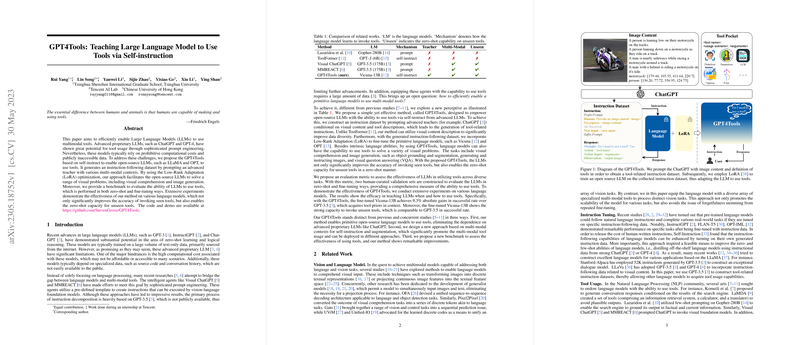Overview of GPT4Tools: Teaching LLMs to Use Tools via Self-instruction
The paper "GPT4Tools: Teaching LLM to Use Tools via Self-instruction" addresses the challenge of facilitating LLMs to employ multimodal tools through a novel framework that relies less on prohibitive computational resources and proprietary data. This work proposes GPT4Tools, which leverages a self-instruction methodology to amplify the tool usage capabilities of open-source LLMs like LLaMA and OPT, potentially democratizing access to advanced AI capabilities.
Methodology and Contributions
The core innovation of GPT4Tools lies in its self-instruct paradigm where a comprehensive instruction-following dataset is generated by engaging an advanced teacher LLM, specifically GPT-3.5, in various multimodal context interactions. The effectiveness of this approach is demonstrated through the low-rank adaptation (LoRA) optimization technique which fine-tunes the LLMs to adeptly handle visual problems, notably enhancing their ability in tasks such as visual comprehension and image generation.
GPT4Tools stands out from previous methodologies by efficiently employing a broader array of multimodal tool usage via self-instruction, reducing reliance on proprietary LLMs, and elevating task diversity with visual content.
Main Findings and Results
The paper reports significant improvements in model accuracy when utilizing seen tools and remarkably affirms a model's zero-shot capacity to navigate previously unseen tools. The introduction of a new benchmark comprehensively assesses tool usage across a variety of tasks, employing both zero-shot prediction and fine-tuning.
The experimental findings highlight the capability of GPT4Tools to improve the performance of LLMs significantly. For instance, Vicuna-13B, a model tuned with GPT4Tools, advances its successful rate by 9.3% over GPT-3.5 when invoking tools and demonstrates competitive performance on new tools, confirming the robustness of the proposed approach.
Implications and Future Directions
The implications of this research are multifaceted. Practically, it suggests a pathway for cost-effective enhancement of open-source LLMs, thereby broadening the accessibility of AI-driven solutions across various domains. Theoretically, it sheds light on the potential of self-instruction to advance the perceptual capabilities of LLMs without the dependency on extensive proprietary data.
Looking ahead, this research may catalyze further exploration into self-instruct methodologies and their applicability in other AI systems, fostering a landscape where adaptable and resource-efficient models become the norm. Future work might focus on refining the scalability and efficiency of implicit tool invocation to streamline computational overhead and extend the models’ adaptability.
In conclusion, GPT4Tools exemplifies a profound step towards equipping LLMs with versatile tool usage capabilities, paving the way for more resource-efficient and universally accessible AI technologies.
